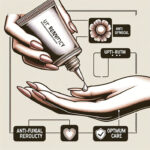When Is It Time to See a Doctor for Fingernail Fungus?

Introduction to Finger Nail Fungus
Finger nail fungus is more common than you might think – it sneaks up on lots of us in one form or another. And while many brush it off as just a cosmetic nuisance, there’s more to it than meets the eye. It’s really about what’s going on beneath the surface of your nails and possibly even a hint that something else isn’t quite right. In the following discussion, we’ll unpack this condition from its early beginnings to those moments when it’s definitely time to consult a doctor. Think of it as a chat with a friend who’s also a seasoned expert, mixing down-to-earth insights with practical advice to help you take charge of your nail health.
Understanding Finger Nail Fungus
Essentially, finger nail fungus is a blanket term for a collection of fungal infections that attack the nail plate. You might notice your nails changing color, thickening, or even developing brittle, crumbling edges. These pesky fungi thrive in warm and damp settings, so if your hands are frequently in moist environments, you could be at risk. While it rarely poses a direct threat to life, it can throw a wrench in your daily activities or even cause discomfort if it’s allowed to spread. The trick is spotting it early, which can open the door to timely treatment and help prevent long-term problems.
Common Causes and Risk Factors
Several things can set the stage for finger nail fungus. Sometimes it’s as simple as a minor cut or a botched manicure that opens the door for infection. Other times, existing skin issues, a compromised immune system, or even family history can tip the scales in favor of fungal trouble. Daily habits like frequent hand washing or exposure to harsh chemicals can also weaken nail integrity, making them more susceptible. Knowing these risk factors can empower you to take preventative measures, such as boosting your nail hygiene and shielding your nails from prolonged moisture.
The Importance of Timely Intervention
When you first sense that something might be off with your nails, it pays to act quickly. Early intervention doesn’t just safeguard the appearance of your nails—it also prevents the fungus from getting a foothold and spreading further. Tackling it early on often means simpler treatments and a lower risk of needing more intensive therapies down the line. Plus, nipping it in the bud can save you a lot of discomfort and the potential hassle of infection spreading to other nails or even nearby people. Keeping an eye on early symptoms and knowing when to switch from DIY fixes to professional care is key to avoiding bigger issues later.
Recognizing the Signs and Symptoms of Finger Nail Fungus
Visible Discoloration and Texture Changes
One telltale sign is a noticeable shift in your nail’s color and texture. You might see shades of yellow, brown, or even white creeping in, taking away that healthy shine. Sometimes, the involved nail gets uneven or develops ridges and crumbling spots where the fungus has started to make itself at home. These symptoms can be pretty subtle at first – just another part of everyday wear and tear – but if they keep progressing, it’s a signal that the infection is gaining ground and might need more than just a bit of self-care.
Differentiating Fungus from Other Nail Disorders
It’s important to note that not every odd nail appearance is due to a fungal infection. Conditions like psoriasis, nail trauma, or bacterial infections can also alter the look of your nails. Fungal infections often stick to a pattern, with discoloration and thickening of the nail, whereas psoriasis might lead to pitting and changes around the nail base. So, if you notice a sudden, dramatic shift in your nail’s texture or color, it might be worth consulting a professional for a proper diagnosis. That way, you’re sure you’re not mistakenly treating a different condition with remedies that just won’t cut it.
When Symptoms Warrant Concern
Occasional discoloration or texture changes could simply be part of normal wear, but consistent issues are a red flag. If you find your nail growing thicker or the discoloration spreading more than just a small patch, it’s a cue that the infection might be on the move. And if there’s even a bit of pain or sensitivity, it suggests that the fungus could be affecting areas deeper than just the nail surface. Recognizing when these changes step over the line from harmless to worrisome is crucial so you can reach out for professional help before complications set in.
Self-Care and Initial Treatments for Finger Nail Fungus
Over-the-Counter Options and Home Remedies
Before swinging the door open to a doctor’s office, many folks try tackling finger nail fungus with over-the-counter treatments or a few popular home remedies. You can find plenty of antifungal creams, ointments, or medicated nail lacquers at your local pharmacy, and they can be a decent first line of defense, especially if you catch the problem early. And then there are the home remedies – tea tree oil, apple cider vinegar soaks – which have gained a devoted following even though the science behind them isn’t rock solid. They may work wonders for some, but if there’s no improvement, it might be time to reassess your approach.
Proper Nail Hygiene Practices
Keeping your nails in top shape is one of the best moves you can make in preventing and managing finger nail fungus. This means a routine that includes regular washing, thorough drying (especially after washing your hands), and even a bit of cautious trimming to cut away damaged or infected parts. Using breathable gloves during chores that involve water and ensuring your nail tools are clean and separate from others can be game-changers. These simple habits form a strong line of defense, making it harder for fungal spores to find a cozy spot to settle.
When Home Treatments Fall Short
Sometimes, even after trying over-the-counter solutions and sticking to a strict nail care routine, the fungus just won’t back down. If you observe the infection spreading or your nail’s condition worsening despite weeks of self-care, it might be time to escalate things. When the fungus digs in deep and home remedies seem to hit a wall, professional medical treatment could be the answer. Knowing when your DIY efforts aren’t enough is crucial for preventing further damage and frustration – and it could save you a heap of trouble in the long run.
When to See a Doctor for Finger Nail Fungus
Persistent or Worsening Symptoms
If your nail fungus isn’t giving up or seems to be getting worse over time, it’s a clear sign to see your doctor. Imagine spending months on treatment only to see no improvement – that’s a strong indicator that the fungus might be resistant to basic remedies. Persistent infections can lead to complications, shake your self-esteem, and in more serious cases, even affect your overall quality of life. Healthcare professionals can offer more powerful, prescription antifungals that target the problem head-on. Getting professional help early can spare you a lot of time and worry.
Spread of Infection Beyond the Nail
Another red flag is when the infection starts venturing beyond the nail itself. If you notice the fungus creeping onto the surrounding skin – sometimes causing conditions like paronychia – or even hopping to other nails, it’s a sign that the infection is playing rough. An expanding infection means a localized treatment might not do the trick anymore, and it could require more systematic, targeted therapy. If the area around your nail starts feeling red, swollen, or warm, it’s time to get professional advice to tackle the issue safely and effectively.
Impact on Daily Functionality
Our hands are our workhorses, and when a nail infection starts interfering with everyday tasks – whether it’s typing on a keyboard or simply gripping something – it shouldn't be taken lightly. If a thickened or distorted nail is making everyday activities a bit too challenging or even painful, then it’s definitely time to consult a healthcare provider. A clear drop in functionality coupled with persistent discomfort is a strong hint that more intensive treatment is needed to get back to doing what you love without disruption.
Pain and Discomfort Indicators
While many start off just worrying about how their nails look, it’s important to pay attention if the fungus brings along any pain or discomfort. Aches around the nail or tenderness when pressure is applied could mean the infection is digging deeper into the tissues. When pain becomes a regular part of your day, it’s a good signal that you shouldn’t wait it out – reaching out for professional advice is the smart move. Addressing discomfort early can ward off more serious complications and help you keep both your nail and overall hand health in check.
Diagnosing Finger Nail Fungus
Clinical Examination Techniques
Diagnosing finger nail fungus usually kicks off with a thorough, in-person evaluation by a healthcare professional. They’ll take a good look at your nail, noting any discoloration, thickening, or odd textures, and might ask you some detailed questions about your nail care routine and any past issues. This hands-on approach offers valuable clues, helping the doctor figure out if the infection is confined to one spot or signals a broader dermatological concern. Using these established clinical techniques, the professional can narrow down the cause and craft a treatment plan that’s just right for you.
Laboratory Tests and Cultures
Sometimes, a visual check just doesn’t cut it, and that’s where lab tests or cultures come into play. A small sample from the nail or the surrounding skin might be taken and sent off for microscopic examination or cultured to pin down exactly which fungus is behind the infection. While these steps might sound a bit involved, they’re critical for making sure you’re targeting the correct pathogen – which in turn means you get the right treatment. Having that laboratory confirmation elevates the accuracy of your diagnosis and helps your doctor set you on a focused treatment plan.
Imaging and Other Diagnostic Tools
In more unusual or stubborn cases, doctors might even resort to imaging techniques like ultrasound or X-rays to check if the infection has burrowed into deeper tissues. These advanced tools can help visualize any structural changes or complications that might require a more aggressive game plan. While imaging isn’t the norm for most nail fungus cases, it underscores the thorough approach practitioners take when a case isn’t typical or is particularly severe.
Treatment Options for Finger Nail Fungus
Topical Antifungal Medications
For mild to moderate cases, topical antifungal treatments are often the go-to solution. You apply these directly to the affected nail and the surrounding skin, letting them work to knock out the fungus where it lives. Over-the-counter options are convenient and widely available, and if those don’t do the trick, your doctor might suggest a stronger, prescription formula. These treatments tend to work locally and don’t usually bring along many side effects, though they do take some persistence and consistent application. They can be a solid first step in your journey back to healthier nails.
Oral Antifungal Treatments
If the infection proves to be widespread or stubbornly resistant to topical treatments, oral antifungals might be the next port of call. These medications work systemically, attacking the fungus both at the infection site and in the surrounding areas. While they can be more potent, they also run the risk of side effects, which means they require close monitoring by a professional during your treatment course. Sticking strictly to the prescribed regimen is crucial to avoid developing resistant strains of fungus. When used correctly, oral antifungals can be a game-changer, especially when the usual treatments just aren’t enough.
Alternative and Complementary Therapies
Alongside traditional treatments, some folks turn to alternative options to add extra muscle to their antifungal strategy. Laser therapy, for instance, has been making waves for its potential to reduce fungal load without the need for systemic drugs. There’s also interest in natural remedies like essential oil blends and herbal solutions, though the scientific backing for these can sometimes be a bit up in the air. While these complementary approaches usually aren’t a standalone cure, they can lend support to your recovery process. Just make sure to chat with your healthcare provider before incorporating any alternative treatments, so they mesh well with your overall plan.
Preventing the Recurrence of Finger Nail Fungus
Maintenance of Nail Health
Keeping finger nail fungus from making a comeback is just as important as nipping the initial infection in the bud. A regular nail care routine can really work wonders – think of it as an investment in long-term nail health. This means frequent trimming, proper cleaning, and always ensuring your nails dry thoroughly, especially in humid conditions. Adding a daily antifungal powder or spray after a shower or workout can also help stave off unwanted spores. By staying on top of these routines, you not only prevent reinfection but also boost your overall hygiene and well-being.
Lifestyle and Environmental Considerations
Your everyday habits and environment can make a big difference too. Simple tweaks like wearing breathable gloves when your hands are in moisture for too long, steering clear of damp settings, or simply ensuring proper ventilation at home or work can cut your risk dramatically. And don’t forget to keep your nail tools – like clippers and files – clean and separate, which curbs the spread of harmful fungi. All in all, a holistic approach that blends smart lifestyle choices with good nail practices can greatly lower your chances of another run-in with fungus.
Regular Check-Ups and Monitoring
Since recurring fungus is always a risk, scheduling periodic check-ups with a dermatologist or podiatrist can really pay off. Regular monitoring means you catch any sneaky signs early, long before they turn into a major headache. It keeps you one step ahead and ensures that your preventive strategies are working – or lets you adjust them if needed. Staying proactive about your nail health is a surefire way to keep fungus at bay.





